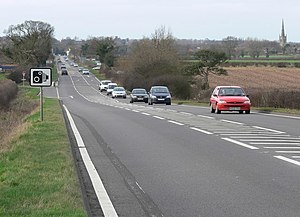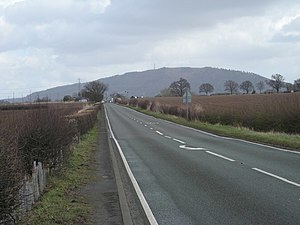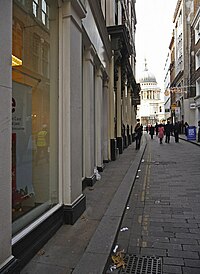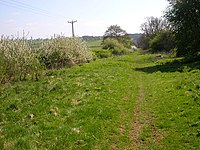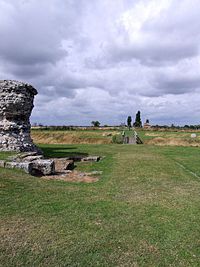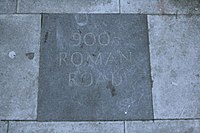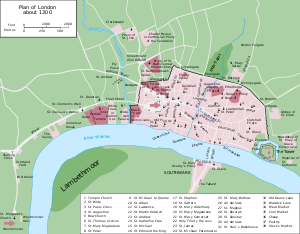Watling Street
Watling Street is a route defined by a Roman road across Great Britain which is to this day marked by busy routes, principally the A5 from London to Shropshire. Bearing the hallmark of a Roman road, much of its route is in straight lines.
There are two principal routes named 'Watling Street', which may be taken as one road. It is the road leading from Marble Arch in the West End of London north-west, initially as the Edgware Road, to St Albans (Roman Verulamium) and thence up through the Chilterns and north-west across the Midlands. It also refers to the road through Kent from the ancient port of Richborough in Kent to Canterbury and ultimately to London. 'Watling Street' is also the name of a small street in the City of London which might have been part of the original route.
The Kentish part of the road is identified on the late-Roman Antonine Itinerary as Iter III: "Item a Londinio ad portum Dubris" – from London to the port of Dover. That route is now marked by the A2 road from Dover to London, while the longer Midlands road is marked by the A5 from London to Wroxeter in Shropshire.
Contents
Name
The Roman road from Londinium (London) to Deva Victrix (Chester) was known as the Via Devana (the Deva Way). The name of the route through Kent is unknown.
The name "Watling Street" is later, and appears in the Anglo-Saxon period; it is named in Old English as Wætlingastræt or on one occasion Wæcelinga stræt (which may be a misreading), and as Wæxlinga stræt. The English word stræt ('street') is a borrowing from Latin, "via strata", and referred to a paved road. The meaning would usually be Wæta's people's street, though any such origin is long lost.
In Old English sources St Albans, amongst other names, is called Wæclingacaester:
- neah ðære ceastre ðe Romane heton Verolamium, seo nu fram Angelðeode Werlameceaster oþþe Wæclingaceaster
It may be therefore that the Wætlingas were people of St Albans and the road is named after that town, as the road from London to Wætlingaceaster.
The Chronicle of Florence of Worcester for the year 1013, gives a mythical explanation, namely that this was the road which the sons of King Weatla made across England.
Route
- Kent: Watling Street begins at the sea, in Dover, and runs inland to the ancient capital of Kent, Canterbury. From here it runs west to Blackheath and to north-eastern Surrey and on to London.
- London: There is dispute as to whether to trace the route to London Bridge and into the City of London (where there is a road named 'Watling Street') or to a presumed ford at Vauxhall and thence up Park Lane or thereabouts to Marble Arch. It may have gone to the ford until the Romans built the first London Bridge into London itself.
- Middlesex: From the site of the Tyburn tree, at the north-east corner of Hyde Park, the Edgware Road begins, which is Watling Street, designated the A5. The road runs in a straight line north-west through the West End to Kilburn and on to Edgware, a little beyond which the route is disrupted by the M1 motorway (and stops being the A5), but heads north towards St Albans.
- Hertfordshire. In a straight line through Radlett and Park Street, Watling Street reaches St Albans; the Roman Verulamium and Anglo-Saxon Wætlingaceaster. Once it ran straight to the site of Verulamium but now the road diverts away over the River Ver to the city centre before following the Ver valley straight up to Redbourn, becomes the A5 again, passing Flamstead to Markyate.
- Bedfordshire: Watling Street, the A5 forms the main axis of Dunstable, and cuts through the county.
- Buckinghamshire: In Buckinghamshire, Watling Street is in Milton Keynes, the "A5" designation moving to an internal bypass but the arrow-straight road remaining in the road layout. The old villages, now districts, of Fenny Stratford and Stony Stratford are named from Watling Street. At the edge of Milton Keynes the street croses the Great Ouse and out of the county.
- Northamptonshire: North of the Great Ouse, Watling Street once formed the boundary of the Danelaw. Its first village is Old Stratford, and then it has a long run across Northamptonshire, through Towcester, to Weeddon Bec, then paralleling the M1 motorway,
- Leicestershire / Warwickshire: Watling Street forms the border of these two counties for most of its length. Hinckley in Leicestershire stands to one side of it, but it is strangely devout of towns or villages until Atherstone, where the road is wholly within Warwickshire, and Tamworth, on the border with Staffordshire.
- Staffordshire and beyond: The road might be said to follow the ancient Via Devana to Chester, but definitions vary.
Mediæval sources
A Middle English source states that Watling Street runs:
From Douere in to Chestre tilleþ Watlingestrete
According to Trevisa it went:
besides Wrokecestre, and then forth to Stratton, and so forth by the myddell of Wales unto Cardykan, and endeth atte Irisshe see.[1]
A number of ancient names that contain the Old English element stræt testify to the ancient route of Watling Street: Boughton Street, Kent; Colney Street, Hertfordshire; Fenny Stratford and Stony Stratford in Buckinghamshire; Old Stratford in Northamptonshire; Stretton under Fosse and Stretton Baskerville, both in Warwickshire; the three adjacent settlements of All Stretton, Church Stretton and Little Stretton in Shropshire; and Stretton Sugwas, Herefordshire.
History
Romans
A Roman road recorded in the Antonine Itinerary as "Iter III" linked London and Dover. The last section of the long Iter II route from Hadrian's Wall travelled through Viroconium Cornoviorum (in Shropshire), past Letocetum (in Staffordshire), Manduessedum, Tripontium, Venonis (Leicestershire), Bannaventa near Norton in Northamptonshire, Lactodurum, then through Stony Stratford and Magiovinium, Durocobrivis (Bedfordshire) (where it crosses the even older Icknield Way), Verulamium (near St Albans, Hertfordshire) and Londinium (by way of the ford at Thorney Island until London Bridge was finished, and the line of the modern Old Kent Road[2]) to Rutupiae on the Kent coast. Another section of Iter II linked Wroxeter to Chester, and other roads were built to Anglesey and into the Cambrian Mountains, but these are not generally considered to be part of Watling Street.
Battle of Watling Street
Part of the route was the site of the Roman victory at the Battle of Watling Street in 61 AD between the Roman governor Gaius Suetonius Paulinus and the Iceni leader, Queen Boudica.
Danelaw
In the 9th century, Watling Street was used as the demarcation line between the Anglo-Saxon and Danish-ruled parts of England. The Treaty of Wedmore divided England between Wessex and the defeated Danes, a line drawn up the River Lea and up the Great Ouse to Watling Street and then along Watling Street to North Wales. Beyond Watling Street lay the Danelaw. Though that border was effective as a frontier for barely a generation, it long remained a jurisdictional boundary and even today, north of the Ouse there are very few villages on the street itself. Watling Street forms the border between Warwickshire and Leicestershire.
Middle Ages and modernity
Like most of the Roman road network, the Roman paving fell into disrepair when the Romans left Britain, although the route continued to be used for centuries afterwards. The Edgware Road became one of the major routes of Middlesex. The main coaching route from London to Dover remained the route of Watling Street.
The road north of London became a turnpike road firstly in 1707 when the section from Fourne hill north of Hockliffe to Stony Stratford was paved following an Act of Parliament on 4 March 1707.[3]
This was the first Turnpike Trust and showed how financially hazardous the undertaking could be.
The Fourne hill to Stony Stratford case provides more evidence that Parliament would void undertakers' rights if they were negligent. The trustees for the Fourne hill to Stony Stratford road borrowed more than 7000 pounds in 1707 and 1708 to improve the road. The creditors, however, claim to have been misinformed regarding the expected revenues from the tolls, and requested in 1709 that a new act extend the term and increase the tolls. A new act was passed in 1709 extending the term, but the tolls were not increased. It also included a provision that the creditors could take receivership of the tolls if the trustees had not repaid their debts by 1711.Apparently, the trustees were unable to borrow and the creditors took over the tolls. In 1716, Parliament tried to clarify the situation by passing an act that vested authority in the trustees from the 1709 act and another group appointed by the Justices of the Peace for Buckinghamshire.
The 1716 act was not amended for its entire term of 23 years, but once it was set to expire, Parliament decided that it would not renew the rights of the existing trustees for the Fourne hill to Stony Stratford road. In 1736, the trustees submitted a petition for an extension of their rights, but it failed to pass and in 1739 their authority ended. In 1740, a new act was passed naming a replacement body of trustees. In the petition for the new bill, the inhabitants of Buckinghamshire described the road as being 'ruined.' This sentiment was affirmed by the
Member heading the committee for the bill.[4]
The road was re-paved in the early 19th century by Thomas Telford who brought it back into use as a turnpike road for use by mail coaches bringing mail to and from Ireland, his road being extended to the port of Holyhead in Anglesey. At this time the section south of London became known as the Great Dover Road. The toll system ended in 1875.
Continued use of the name along the ancient road
The use of the street name is retained along the ancient road in many places: for instance, in Bexleyheath in Kent and on through the county (including the towns of Canterbury, Gillingham, Strood, Gravesend and Dartford). North of Middlesex, the name 'Watling Street' still occurs in Hertfordshire (including St Albans), Bedfordshire, Buckinghamshire (Milton Keynes), Northamptonshire (including Towcester), Leicestershire, Warwickshire (including Nuneaton), Staffordshire (including Cannock, Wall, Tamworth and Lichfield) and Shropshire (including in Church Stretton as the residential Watling Street North and South).
A section of Watling Street still exists in the City of London close to Mansion House underground station on the route of the original Roman road which traversed the River Thames by way of the first London Bridge and ran through the City in a straight line from London Bridge to Newgate.[5]
Outside links
| ("Wikimedia Commons" has material about Watling Street) |
- The Antonine Itinerary
- 'Watling Street – A Journey through Roman Britain' web page by the BBC
- Stone Street, Suffolk – Thayer
References
- ↑ Polychron. bk. i. c. 45
- ↑ Margary, Ivan D. (1948). Roman Ways in the Weald (third ed.). London: J. M. Dent. pp. 126.
- ↑ House of Lords Journal Volume 18
- ↑ Bogart, Dan (2007). "Evidence from Road and River Improvement Authorities, 1600–1750" (PDF). Political Institutions and the Emergence of Regulatory Commitment in England. University of California. http://www.iisg.nl/hpw/papers/law-bogart.pdf. Retrieved 3 June 2008.
- ↑ Britain's hidden history – London's missing Roman road.
- O. Roucoux, The Roman Watling Street: from London to High Cross, Dunstable Museum Trust, 1984, ISBN 0-9508406-2-9.
